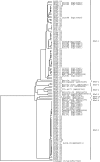Detection of human parechoviruses from clinical stool samples in Aichi, Japan
- PMID: 20519478
- PMCID: PMC2916555
- DOI: 10.1128/JCM.00086-10
Detection of human parechoviruses from clinical stool samples in Aichi, Japan
Abstract
Between April 1999 and March 2008, a total of 4,976 stool specimens collected from patients with suspected viral infection through infectious agent surveillance in Aichi, Japan, were tested for the presence of human parechoviruses (HPeVs). We detected HPeVs in 110 samples by either cell culture, reverse transcriptase PCR (RT-PCR), or both. Serotyping either by neutralization test or by nucleotide sequence determination and phylogenetic analysis of the VP1 region and 5' untranslated region (5'UTR) regions revealed that 63 were HPeV type 1 (HPeV-1), followed by 44 HPeV-3 strains, 2 HPeV-4 strains, and 1 HPeV-6 strain. The high nucleotide and amino acid sequence identities of the Japanese HPeV-3 isolates in 2006 to the strains previously reported from Canada and Netherlands confirmed the worldwide prevalence of HPeV-3 infection. Ninety-seven percent of the HPeV-positive patients were younger than 3 years, and 86.2% younger than 12 months. The clinical diagnoses of HPeV-positive patients were gastroenteritis, respiratory illness, febrile illness, exanthema, "hand, foot, and mouth disease," aseptic meningitis, and herpangina. Among 49 HPeV-positive patients with gastroenteritis, 35 were positive with HPeV-1 and 12 with HPeV-3, and out of 25 with respiratory illness, 11 were positive with HPeV-1 and 14 with HPeV-3. HPeV-3 seemed to be an important etiological agent of respiratory infection of children. While HPeV-1 was detected predominantly during fall and winter, the majority of the HPeV-3 cases were detected during summer and fall. A different pattern of clinical manifestations as well as seasonality suggested that there are different mechanisms of pathogenesis between HPeV-1 and HPeV-3 infections.
Figures



References
-
- Abed, Y., and G. Boivin. 2005. Molecular characterization of a Canadian human parechovirus (HPeV)-3 isolate and its relationship to other HPeVs. J. Med. Virol. 77:566-570. - PubMed
-
- Benschop, K. S. M., J. Schinkel, R. P. Minnaar, D. Pajkrt, L. Spanjerberg, H. C. Kraakman, B. Berkhout, H. L. Zaaijer, M. G. Beld, and K. C. Wolthers. 2006. Human parechovirus infections in Dutch children and the association between serotype and disease severity. Clin. Infect. Dis. 42:204-210. - PubMed
MeSH terms
Substances
Associated data
- Actions
- Actions
- Actions
- Actions
- Actions
- Actions
- Actions
- Actions
- Actions
- Actions
- Actions
- Actions
- Actions
- Actions
- Actions
- Actions
- Actions
- Actions
- Actions
- Actions
- Actions
- Actions
- Actions
- Actions
- Actions
- Actions
- Actions
- Actions
- Actions
- Actions
- Actions
- Actions
- Actions
- Actions
- Actions
- Actions
- Actions
- Actions
- Actions
- Actions
- Actions
- Actions
- Actions
- Actions
- Actions
- Actions
- Actions
- Actions
- Actions
- Actions
- Actions
- Actions
- Actions
- Actions
- Actions
- Actions
- Actions
- Actions
- Actions
- Actions
- Actions
- Actions
- Actions
- Actions
- Actions
- Actions
- Actions
LinkOut - more resources
Full Text Sources
Medical
Miscellaneous

